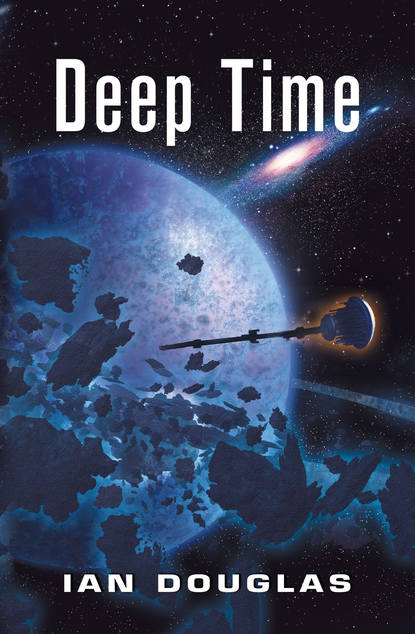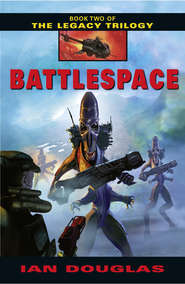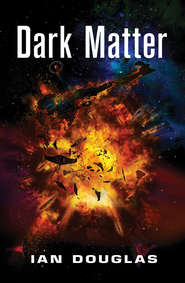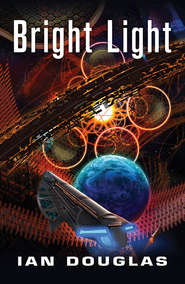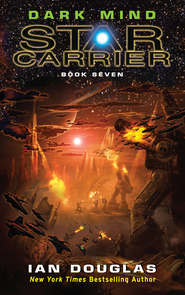По всем вопросам обращайтесь на: info@litportal.ru
(©) 2003-2025.
✖
Deep Time
Настройки чтения
Размер шрифта
Высота строк
Поля
“You apes heard the el-tee,” Swayze growled over the company tactical channel. “On your feet! Face front! When the nano kicks open the door, I want to see nothing but amphibious green blurs moving through that collar!”
“Amphibious green” was an anachronism, of course, but one long beloved of the Corps. Each Marine in the assault platoon was clad in full Mark I armor—the curving, black, nanoflaged surfaces scattering back a bewildering kaleidoscope of shapes, colors, and lights from the red-lit interior of the Crocodile transport. The nanoflage picked up on lights and colors surrounding the armor and transmitted it back. In the field, it provided what amounted to functional invisibility, but within the cramped confines of the Croc’s cargo deck it just gave you a functional headache.
A shudder ran through the Croc as it nosed into the fortress wall. According to the plans Swayze had seen, the wall here was two meters thick. It would take a few seconds for the collar to eat its way through that.
Something clanged against the Crocodile’s hull, sharp and insistent. Swayze heard the whine of the landing craft’s turrets slewing to port, followed by the howl of exciters and cooling pumps as the weapons opened up with a few thousand megawatts of high-energy laser response. Up forward, the docking collar was slowly extending, growing its way into the stone of the fortress wall, converting concrete and iron into free-flowing atoms and directing them along the tunnel’s interior surfaces where they froze as an ultra-hard crust supporting the opening. In space, a nano docking collar allowed Marines to tunnel through the hull of an enemy spacecraft without losing internal pressure. Here, pressure wasn’t an issue. They just needed to burrow through those two meters of concrete and steel … and do so before the enemy had time to respond.
When they were down to the last few centimeters, the Crocodile fired a series of probes through the remaining stone, putting insect-sized battlespace drones into the interior of the fortress. Swayze’s in-head showed what those drones were seeing—a dozen heavily armored Confed soldiers crouched in a broad stone tunnel, weapons ready.
This was not going to be pretty.
“We’ve got bad guys to either side of the entrance,” he told the others, “and straight ahead. Lead fireteam, focus on the ones straight ahead. The ones to either side will be worried about scoring own-goals.”
The defense obviously had been thrown together in a hurry, with nearby soldiers rounded up and pointed at the breach site. Putting gunners on both sides of the breach was a great way to ensure that some of them would suffer friendly fire.
He didn’t envy the lead fireteam, though. Two of them were manhandling bulky mirror shields, but they would be taking fire from three sides.
“Here we go!” Widner called.
The Croc’s interior docking hatch dilated open and the waiting Marines surged forward.
“Go! Go! Go!” Swayze yelled.
The door kickers went through first, crouched behind their shields. Those mirrored surfaces—backed by energy-damping exotic-material ceramics—would give them a fair degree of protection from handheld lasers and projectiles, but not as much from plasma beams. Blocked by the armored shapes in front of him, Swayze couldn’t see what was happening up ahead; an in-head window displayed the heart rates of the lead fireteam, but not their helmet-camera feeds. He needed to be focused on the entire platoon, not just the tacsit of the four in front.
“Watch it! We’re taking fire!” That was Corporal Addison, in the lead fireteam.
“Gaynor is down! Man down!”
An explosion sounded from ahead, and the Crocodile rocked with the concussion. The Marines kept filing forward, though, smoke billowing back into the transport’s interior. Swayze stooped low as he entered the docking collar and pressed into the tunnel. He was positioned halfway back in the line, which meant there were twenty Marines—four fireteams—in front of him.
Then he was through, stepping into a narrow passageway with walls, floor, and ceiling all of stone blocks. Two Marines were down on the deck, both still moving; a dozen Confed troopers were visible in the passageways left, right, and straight ahead.
The Marines stormed the fortress.
Emergency Presidential Command Post
Toronto
United States of North America
0012 hours, EST
For President Alexander Koenig, it was as though he was actually there.
His staff had set up the direct link, and he was riding the transmitted thoughts and sensory impressions of Lieutenant Franklyn K. Widner’s Mark I combat armor. Those neural signals were being transmitted to the complex web of circuitry grown atom by atom through Koenig’s cerebral cortex.
As far as Koenig could tell, he was inside Lieutenant Widner’s armor, moving through dark stone corridors, following the electronic maps being thrown up against his visual field by the in-head circuitry. He could hear the shouts of the men over the tactical channel, hear Widner’s orders and the rasp of his breathing; even feel the mass and give of the armor as it responded to Widner’s movements. The only limitation was his lack of somatic control; he was a passenger only, receiving sensory impressions but unable even to turn his head to see what was beside him.
“Talman! Gonzales!” Widner was shouting. “Put fire on that passageway. Two o’clock!”
Everything was noise and confusion. Briefly, Koenig considered pulling back to the feed from one of the battlespace drones, but he preferred to hold on to the connection with the platoon commander. He could transmit messages to Widner over the tactical channel, but Koenig was a Navy veteran himself, and knew how frustrating—and outright deadly—micromanagement was. Widner didn’t need his input, and certainly wouldn’t appreciate it. Koenig continued to simply ride the boil and tumble of the firefight.
Besides, what Koenig was witnessing now was only a tiny part of the whole of Operation Fallen Star. Three other platoons of Alfa Company were inserting by Crocodile nearby, and a flight of ponderous Choctaw UC-154 shuttles—each carrying two hundred Marines—were coming in behind the Croc first wave. Fallen Star was an orbit-to-ground insertion of a full battalion: more than a thousand Marines, plus their support personnel.
And still, Koenig wondered if it would be enough. Verdun had a nasty reputation.
Verdun, a city on the Meuse River in northeastern France that had repulsed Attila the Hun, had by the early twentieth century become a defensive complex of twenty-eight forts. The meat-grinder battles of 1916 had slaughtered something like 150,000 Frenchmen and very nearly that many Germans. Fort Douaumont had been the largest of the French strongholds, with outer walls four hundred meters long, and comprising two underground levels, multiple casements and turrets, and living spaces for hundreds of men. After the war, Douaumont had become a war museum and remained so … until the beginning of the Sh’daar conflict in 2367. At that point, the Pan-European Union enlarged and deepened the facility, adding missile silos and plasma beam turrets and turning it into a planetary defense base.
The intent had been to protect the European Union from a Sh’daar attack, a scenario that had become all too possible when the Turusch had penetrated Earth’s outer system defenses in 2404, slamming a high-velocity kinetic-kill impactor into the Atlantic Ocean. Nobody, Koenig thought, had ever imagined that the ancient fortress at Douaumont would become the last-ditch refuge of the followers of General Janos Matonyi Korosi, the Butcher of Columbus and the leader of the Earth Confederation.
Events had proceeded in a chaotic tumble since the civil war between Confederation and the United States of North America had begun. Korosi, the USNA intelligence services believed, had been responsible for the nano-D strike against Columbus, D.C., formerly the USNA capital, an attack that constituted an almost unthinkably vicious war crime. Roettgen, the Confederation’s president, had vanished not long after—either a prisoner or murdered by Korosi’s thugs. A new president of the Confederation had been appointed from the Confederation Senate, Christian Denoix de Saint Marc, but smart money said he was either an innocent dupe or a corrupt front man for Korosi.
Then the USNA computer net facility at Cheyenne Mountain had launched Operation Luther, using the science of recombinant memetics to introduce a new religion into the Confederation’s electronic networks and social infrastructure. The new religion, called Starlight, had caught hold with astonishing speed, bringing with it a popular revulsion against a government that could condone the nano-disassembly of a city center, including hundreds of thousands of its civilians. A grassroots revolution had swept the ruling Globalist Party from power, and almost brought the civil war to an end.
Almost …
Geneva, the Confederation capital, had fallen to Starlightist rebel forces just two weeks ago. Working through electronic back doors put in place during Operation Luther, USNA Intelligence had been searching for the fallen regime’s leaders, and for Ilse Roettgen. They now believed that both Denoix and Korosi were in Douaumont, and the chances were good that Roettgen, if she was still alive, was there as well.
Catch Korosi and his stooges, and the war might be over for good.
And so, Koenig had authorized Fallen Star, a high-risk assault with the sole purpose of killing or capturing Korosi and Denoix, rescuing Ilse Roettgen, and bringing the nasty little war to a close.
Once that was done, Koenig reflected, all that was needful was to end the Sh’daar War, figure out what the Rosette Aliens wanted, and bring half of Earth back under a legitimate, reasonable, democratic, and above all peaceful government, one that would both recognize USNA independence and work with the United States to strengthen Humankind’s interests, both on Earth and throughout North America’s far-flung interstellar colonies.
Nothing to it.
“Concentrate on twelve o’clock! Hit ’em! Hit ’em!”
“Marine down! Marine down! Corpsman front!”
“Move, move, move …”
“First Section!” That was Widner’s voice, both on audio and transmitted in-head over the tactical channel. “With me!”
A passageway yawned ahead, with gray stone slabs underfoot and to either side. There was something up ahead, at the end of the corridor, but Widner’s helmet AI was having trouble parsing it out. What the hell was that?
Armored shapes rose from behind the object, which revealed itself now as an impromptu barricade: a jumble of furniture, concrete blocks, and steel drums blocking the stone corridor.
And behind it …
“Watch it! Damn it, watch it!”
Something slammed into Koenig’s chest, staggering him. It took him a dazed moment to recognize that he’d not been hit, but that a white-hot plasma bolt had slammed into Widner’s combat armor. Widner’s heart and respiration readouts went ragged, then dropped toward flatline. Koenig felt trapped, staring at the stone slabs of the corridor’s ceiling, unable to move, unable to do anything but lie there.
Widner died, and his armor began shutting him down for medevac and resuss …
VFA-96, Black Demons





